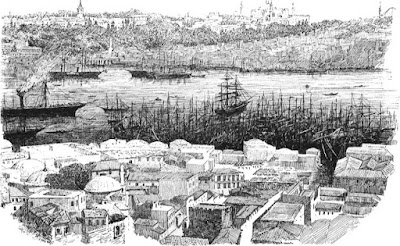Okay, this is the last post exploring the incredible sights (and often smells) of Constantinople's Northern Shore. For the next couple of week, I'll be assembling these posts together into a fully illustrated PDf. You'll get some glimpses of the art next Friday.
Tophane Fountain
Constantly teeming with hamals, vendors, commuters, and sailors, the streets of Tophane are the busiest arteries in Pera-Galata. In 1732, Sultan Mahmud I commissioned the building of Tophane Fountain, one of the largest and most beautiful fountain kiosks in Constantinople, to provide drinking water for the passing crowds. He may have committed this charitable deed to curry favor with his subjects after having over 7,000 members of a revolt executed.
The four ornate walls of the fountain kiosk form a large white marble square twenty-six feet high. Each identical side possesses an inset arch with a water-dispensing spigot above a trough surrounded by arabesque reliefs of trees, roses, and calligraphy in gold plate. Despite possessing a dome with overhanging eaves in its original construction, renovations in 1837 crowned the fountain kiosk with a veranda surrounded by a protective balustrade matching the dimensions of its walls. Tall trees growing up around the fountain shade the many thirsty visitors to the fountain from the sun’s rays.
The freely given water draws people from every nation and class to fountain square. Livestock slake their thirst at the water troughs. Tired laborers wash under the cistern’s cool stream. Servants and sons fill their buckets with water for household uses. Nithamiyeen faithful perform their ritual washings kneeling at the fountain’s troughs before praying at the nearby Kilic Ali Pasha mosque. Peddlers of vegetables and fruits gather their stalls in the square around the fountain.
Nusretiye Mosque and Clock Tower
On the far eastern end of the fountain square, the sharply pointed twin minarets and dome of Nusretiye Mosque rise over the east side of Tophane. In 1823, construction began to rebuild the mosque attached to the Tophane barracks which had been damaged in a fire. Work completed in 1826, only a few months after the Sultan Mahmud II defeated the Janissaries in “the Auspicious Incident”. The Sultan commemorated his recent eradication of the Janissary class by naming his new mosque “Nusretiye” meaning “Divine Victory”. To this day, Nusretiye remains a symbol of Tanzimat reforms.
Nusretiye is an unusually large mosque and its grand baroque architecture makes it even more distinctive. High granite walls with rectangular windows enclose the building. Short turrets grow around the mosque’s majestic 108-foot tall dome. A raised foundation lifts the mosque above the receding ground of the Bosporus shore and brings its minarets closer to the sky. In the vast, square prayer hall, four arches growing from the corners of the room support the magnificent ceiling elaborately ornamented with gold and shades of blue.
To the east of the mosque stands a rare sight in the Ottoman Empire, Nusretiye Clock Tower. Turks prefer to keep the time of day by the muezzin’s call to prayer than the loud ringing of bells. Sultan Abdulmejid modernized punctuality in Tophane by building a clock tower for his father’s mosque in 1848. The 50-foot tower of extravagant neoclassical style offends traditional Ottomans. The chimes remain unused, but the tower’s silence is not enough to keep the peace. Only the monogram of the sultan sealed above the tower’s doorway stops vandals and zealots from damaging the delicate mechanisms, stopping the tower’s four clock faces for good.







